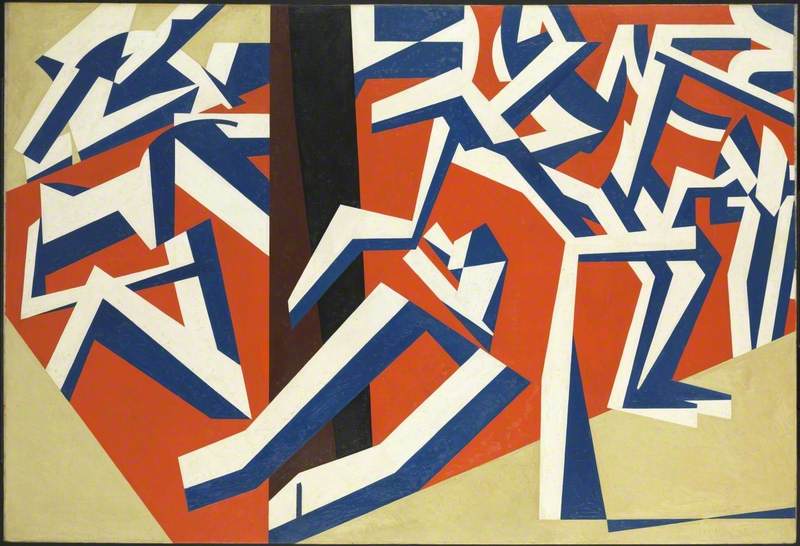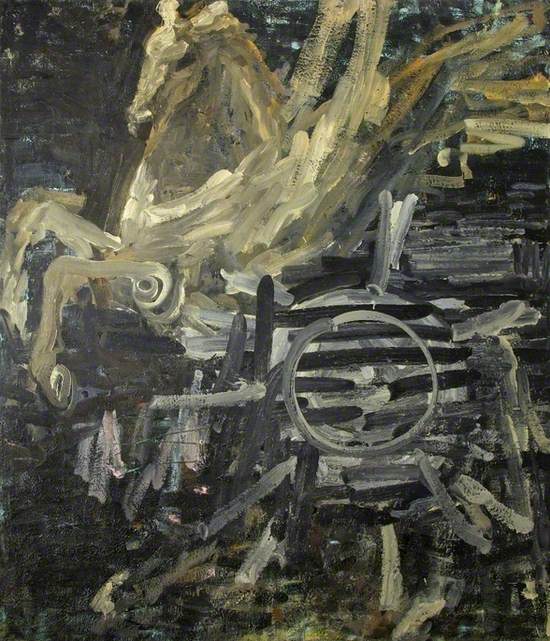The twentieth century was a time of unprecedented freedom of expression in art, where new visual languages broke time-honoured rules. This newfound creative autonomy bought with it a number of movements and groups with varied agendas, and whilst some complimented one another, others pulled in opposite directions. This exhibition tells a vibrant story of modern British art through artworks from Swindon Museum and Art Gallery, from the late 1880s to today.
Accompanying blog posts about the groups and artworks in this exhibition are available through http://www.swindonmuseumandartgallery.org.uk/artontour
New English Art Club
The New English Art Club (NEAC) was founded in 1886, by a group of artists who wished to capture the naturalistic effects of light in a landscape. They rebelled against the morality-driven art of the Victorians, and explored new ways to represent the world around them with renewed vigour and vitality. Sir George Clausen was a founder of the NEAC, and is known for his depictions of peasant life against atmospheric rural backdrops. The Reapers depicts the three men carrying out the laborious work of harvesting crops. The low positioning of the sun casts certain elements of the scene into shadow or silhouette, whilst others reflect its bright light. This demonstrates Clausen’s skill for capturing the ephemeral effects of light in nature.
The Camden Town Group
Between 1911-13, artists of the Camden Town Group drew their subject matter from the world surrounding them, embracing the essence of modernity through its people and its places. In doing so, they used techniques that captured light, colour and form with more intensity than was seen previously in British art. The group was named after the area in London where its founders Walter Sickert and Spencer Gore lived and worked at the time. Gore’s portrait depicts Marie Hayes, a model who posed regularly for both artists. The portrait was painted early on in the Camden Town Group’s short lifespan, and shows Gore’s talent for capturing the play of light on a subject through rapid brushstrokes and colour.
The Bloomsbury Group
Artists of the Bloomsbury Group embraced the idea that art should be led formal design elements such as line, colour, shape, space and rhythm. They did not care about reflecting reality, but believed an image should have a reality of its own. The Bloomsbury Group were also revolutionary in the way they broke down divisions between fine art and craft. Art no longer belonged to the realm of the gallery, but could be a part of everyday life. Prominent Bloomsbury artist Vanessa Bell created Nude with Poppies, which is defined by flat planes of colour, bold outlines, and a lyrical, organic quality. Though a striking artwork in itself, it is actually a design for a bed headboard, depicting a nude of simplified forms beneath two large poppies.
Vanessa Bell (1879–1961)
Oil on canvas
H 23.4 x W 42.4 cm
Museum & Art Swindon
.
Vorticism
The Vorticist group formed in 1914, and embraced the speed and dynamism of the modern machine age. Artists conveyed this by reducing their subjects to hard, geometric patterning, and creating energetic compositions made from bold lines, geometric shapes and harsh colours. After witnessing the horrors of WWI, many of its artists felt disillusioned with the machine age, including William Roberts, who had been one of eleven to sign the Vorticist Manifesto in support of its ideas. Study for Bank Holiday in the Park was created after the group dispelled, but we can see the remnants of the movement’s visual language in the angular, faceless figures and the dynamic composition, which draws the eye diagonally across the image.
William Patrick Roberts (1895–1980)
Charcoal on paper with green wash, squared up for transfer in red ink
H 25.4 x W 20.3 cm
Museum & Art Swindon
The London Group
In 1913 the Camden Town Group transformed into The London Group in order to embrace and exhibit the whole spectrum of modern art in the capital. This included work by the Camden Town artists, the Bloomsbury Group and the Vorticists, though their ideas sometimes directly opposed to one another. David Bomberg was a founder member of the London Group. The South-East Corner, Jerusalem captures the luminosity of a landscape bathed in low-lying morning sun. The rolling hills and architectural details are painted with bold, structural blocks of jewel-like colours. Often a single brushstroke describes a lot with a little, reflecting the reduction of forms and erasure of irrelevant visual material, which modern painters advocated at this time.
David Bomberg (1890–1957)
Oil on board
H 55.5 x W 73.2 cm
Museum & Art Swindon
.
Unit One
Unit One formed in the mid-1930s with the aim of embracing both abstraction and surrealism. The group was led by Paul Nash, who wanted the work to show "the expression of a truly contemporary spirit". Its 1934 exhibition Unit One: The Modern Movement in English Architecture, Painting and Sculpture helped to establish London as a centre for abstract art. Ben Nicholson’s Composition in Black and White was painted the same year Unit One was launched, and marked a move away from recognisable subject matter and towards pure abstraction. It is characterised by a monochrome colour palette and a variety of textured surfaces, into which he scraped a gestural combination of straight and curved lines, to reveal a white painting underneath.
Ben Nicholson (1894–1982)
Oil & gesso on board
H 112 x W 53 cm
Museum & Art Swindon
The Seven and Five Abstract Art Group
The Seven and Five Society was founded in 1919 to promote traditional values in art, in reaction to the emergence of modern art movements. However, in 1924, abstract art pioneers joined and transformed it into the Seven and Five Abstract Group. They organised the first all-abstract exhibition at the Zwemmer Gallery in London in 1935. Such a dramatic change in ethos meant most of the original members retreated, and Ivon Hitchens was the only artist to stay in the group from start to finish. In The Chinese Bowl Hitchens attempts to shows us the essence of the scene, rather than a direct imitation. As such, he reduces the forms to flat, painterly planes of colour, which lead the eye from one element to another.
Neo-Romanticism
In the 1930s Neo-Romantic artists sought a return to the traditional subject matter of landscape painting, but transformed it through their understanding of modernism and the threat of impending war. They conveyed emotion through heightened imagery in a similar vein to Romantic landscape painters of the 19th century, but used modern artistic languages. Through his striking landscapes, John Piper aimed to evoke the spirit of a place. Pistyll Maes-Glasau depicts a waterfall in Gwynedd (Wales) with a 600 foot drop. Piper has captured the height and energy of the waterfall by emphasising its luminosity. The contrast between light and dark, and the expressive manner with which he has captured the scene, conjures an awe-inspiring vision.
John Piper (1903–1992)
Chalk, charcoal & gouache on paper
H 50.2 x W 37.5 cm
Museum & Art Swindon
Surrealism
Surrealism is an artistic, literary and philosophical movement, which emerged in France in the mid-1920s and transformed art throughout Europe. It was influenced by developments in theories of the unconscious and its artists embraced the idea that art did not need to be shaped by reason or aesthetic judgements. They enjoyed creating artworks and objects that were unexpected, uncanny and unconventional. Desmond Morris was born in 1928, and emerged as a surrealist painter in the 1950s. The Mysterious Gift presents a selection of unusual and strangely presented objects. A vessel resembling a fruit bowl or wine glass contains organic forms, which are open to the viewer’s interpretation.
Desmond Morris (b.1928)
Oil on canvas
H 99 x W 70.7 cm
Museum & Art Swindon
The Euston Road School
The Euston Road School was founded in 1938, and consisted of realist artists who taught and studied at the School of Painting and Drawing at Euston Road in London. Its artists encouraged observation and social relevance, and stood against the spectacle of Surrealism. Though brought to an end by the outbreak of war, The Euston Road School offered an alternative to the increasing predominance of abstraction. Lawrence Gowing’s Portrait of a Youth depicts the actor Alfie Bass, and demonstrates Gowing’s close observation of his sitter, whom he depicted many times. Its small size and intimate cropping, combined with the relaxed expression of the sitter, demonstrate Gowing’s desire for closer involvement with his sitters.
Lawrence Gowing (1918–1991)
Oil on canvas
H 24.5 x W 19 cm
Museum & Art Swindon
The St Ives School
The term ‘St Ives School’ refers to the artists associated with St Ives from the 1940s-60s, when it was the centre for modern and abstract developments in art. Terry Frost moved to Cornwall in 1946 and became a key member of the St Ives School. Grey, Red and Black Verticals is an abstract painting characterised by bold black and red forms. It is, in part, a celebration of Frost’s love of the colour black, which has a powerful presence in this piece. Though the title alludes to the formal qualities of the work, it is not completely devoid of narrative reference. The suspended forms at the top of the canvas were inspired by Peter Paul Rubens’ painting The Judgement of Paris, at the National Gallery.
Terry Frost (1915–2003)
Oil on canvas
H 101 x W 126.5 cm
Museum & Art Swindon
Pop Art
Pop Art emerged in the 1950s and flourished in Britain and America in the 1960s. Its artists rebelled against traditional art forms and responded to an increasingly consumer-driven culture and developments in technology. Artists were inspired by popular imagery like advertising, product packaging and comic books. Richard Hamilton’s work aimed to break down boundaries between high and low art, and reflected his interest in two innovations of the era - modern technology and mass media culture. Interior Study (a) is a collage constructed of imagery from a number of sources. The female figure was cut out of an advertisement for a washing machine, and in her new context admires a TV screen, which has replaced a painting on an easel.
Richard Hamilton (1922–2011)
Oil & collage on paper
H 38.1 x W 50.8 cm
Museum & Art Swindon
Minimalism
The term "minimalism" came into use in the 1960s to describe art that was stripped of subject matter and expression. Sculpture favoured industrial materials, and painting was reduced down to simple geometric forms. In doing this, minimalist artists sought to alter environments, and find new relationships between an artwork and its surroundings. Roger Cook’s R 25 is comprised of six equal boards measuring 10 x 61cm, encased in canvas and painted with monochromatic tones of acrylic. This reflects minimalism’s aim to achieve equality of parts, repetition and neutral surfaces. R 25 does not represent a particular subject matter or personal response, but rather considers the relationship between basic forms and their environment.
Conceptualism
In the 1960s, '70s and ‘80s, conceptual artists placed importance on the ideas behind an artwork and our intellectual understanding of it, rather than the final art object. Michael Craig-Martin’s work often questions the way we perceive objects. The Box that Never Closes has the smooth, white finish of a domestic appliance and therefore gives the impression of functionality. However, it does not have a purpose, and even its basic use as a box is denied because it cannot be fully closed. Yet the mind completes the cube by imagining that the lid should close. Therefore Craig-Martin plays with the push and pull between actual and imagined looking. Conceptualism still plays a big part in many art practices today.
Michael Craig-Martin (b.1941)
Blockboard, polyurethane paint, varnish & brass hardware
H 61 x W 61 x D 61 cm
Museum & Art Swindon
Land Art
Land Art evolved from conceptualism’s claim that art should be an idea, rather than an object. It involves making temporary, physical interventions in a landscape, which may take the form of a journey or a creation of an installation from the site’s natural materials. As such documentation is often the only existing evidence of the work. Richard Long is a pioneer of landscape art. He started making small interventions in landscapes in the 1960s, and continues to do so today. Two Walks from 1972 is part of a larger body of work Long produced to explore the landscape of Dartmoor, altering his walks to examine the effect on his experience of the place. It presents an Ordnance Survey map of the area, on which the artist has marked his routes.
Richard Long (b.1945)
Pencil & collage on ordinance survey map laid on card
H 61 x W 84 cm
Museum & Art Swindon
Neo-Expressionism
Neo-Expressionism emerged in the 1980s in reaction to the sterility of minimalist and conceptual art. It drew inspiration from expressionist art of the early 20th century, which was driven by emotion and subjectivity. Neo-Expressionism is characterised by animated mark making, strong emotional content and raw, energetic painting styles. Its artists revived mythological and historical subject matter, as well as a focus on self-expression. Christopher Le Brun’s Hyperion depicts the flying horse Pegasus from classical mythology. A wheel-like form, thought to represent a broken column, adds great dynamism to the piece. Large gestural strokes of paint are built up in several textural layers, giving the overall impression of energy and drama.
The School of London
The School of London was a loose group of London-based artists, who explored figurative painting and drawing in the 1970s and ‘80s. The term was coined by R.B. Kitaj, who aimed to draw attention to artists exploring figurative art, at a time when abstract movements were fashionable. Kitaj was interested in depicting the human figure and conveying human experience in his art. Sketch of CBD with Auerbach Drawing depicts an anonymous nude, pregnant woman reclining on a chaise-longue designed by Le Corbusier. In the background, a painting by Frank Auerbach, another important School of London artist, is depicted with expressive and angular marks. The female figure is skilfully drawn with confident strokes of charcoal.
Ronald Brooks Kitaj (1932–2007)
Charcoal on paper
H 57 x W 78 cm
Museum & Art Swindon
Sensationalism
Sensationalism is a movement associated with the Young British Artists, who emerged in the late 1980s and 1990s. Their work is characterised by playfulness, dark humour, confrontational themes and edgy approaches. Stylistically, John Greenwood’s work is inspired by 17th Century Dutch still life painting, but the subject matter is the product of his imagination. Rings and Strings and Things takes us into a dream-like world filled with bodily forms which twist, leak and pulsate. Greenwood makes a humorous and grotesque statement about the blurred boundaries between the private and public spaces occupied by the body.
John Greenwood (b.1959)
Oil on canvas
H 134 x W 180 cm
Museum & Art Swindon
Contemporary British Painting
Contemporary British Painting (CBP) is an artist-led organisation which promotes current trends in British painting. In 2013 Swindon Museum and Art Gallery acquired a collection of 40 works by 24 leading painters working in Britain. The donation highlights a move towards a 'new individualism', where artists are seeking to engage with ideas of personal memory and social experience. Robert Priseman’s Home series consists of six miniature paintings within antique Indian shrines, each depicting a home where a crime took place. Priseman looks at how the home can be a place associated with sanctuary and nurture, but also tragedy. By placing these images in shrines, he encourages us to meditate on what these places mean to us now.
Explore artists in this Curation
View all 19-
 Ivon Hitchens (1893–1979)
Ivon Hitchens (1893–1979) -
 William Patrick Roberts (1895–1980)
William Patrick Roberts (1895–1980) -
 Vanessa Bell (1879–1961)
Vanessa Bell (1879–1961) -
 Roger Cook (b.1940)
Roger Cook (b.1940) -
 Terry Frost (1915–2003)
Terry Frost (1915–2003) -
 George Clausen (1852–1944)
George Clausen (1852–1944) -
 Desmond Morris (b.1928)
Desmond Morris (b.1928) -
 Lawrence Gowing (1918–1991)
Lawrence Gowing (1918–1991) -
 David Bomberg (1890–1957)
David Bomberg (1890–1957) -
 Christopher Le Brun (b.1951)
Christopher Le Brun (b.1951) - View all 19


















